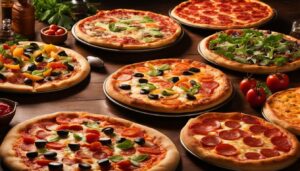Choosing the Best Loaf Pans for Your Bread Baking Needs
Picture this: it’s a Sunday morning, the smell of freshly baked bread fills the air, and you can’t wait to enjoy a slice of warm, homemade goodness. But as you take your loaf out of the oven, you’re disappointed to find that it’s unevenly browned, sticking to the pan, and far from the picture-perfect loaf you had envisioned.
Don’t worry, we’ve all been there. The secret to baking those perfect loaves lies in choosing the right loaf pans. These essential baking tools can make or break your bread-baking experience, so it’s crucial to invest in quality baking equipment.
Whether you’re an avid baker or just getting started, finding the right loaf pan is key to achieving those bakery-worthy results. That’s why we’ve done the research and put together a comprehensive guide to help you choose the best loaf pans for your bread baking needs.
Testing and Results of Loaf Pans
A comprehensive testing process was conducted to determine the best loaf pans available. We wanted to ensure that our recommendations were based on reliable data and real-world performance. To do this, we put several popular loaf pans to the test, evaluating their performance in various aspects. Our goal was to find a loaf pan that consistently delivered excellent results, from the overall appearance and texture of the bread to the ease of use and cleanup.
Types of Tests Conducted
To evaluate the loaf pans, we conducted a series of tests that covered all aspects of bread baking. Here are the tests we carried out:
- Loaf Pan Test: White Bread
- Loaf Pan Test: Banana Bread
- Loaf Pan Test: Sourdough Bread
- Usability Test
- Durability Test
- Cleanup Test
By conducting multiple tests, we aimed to provide a comprehensive assessment of each loaf pan and identify the one that excelled in all categories.
Testing Methods and Results
For each baking test, we followed a standardized recipe and baking process to ensure consistency. We made sure to use the same ingredients, measurements, and baking times for each loaf pan.
After conducting the tests, we carefully evaluated the results based on the following criteria:
- Even Browning: We assessed how evenly each loaf pan browned the bread, ensuring a consistent appearance.
- Loaf Release: We checked how easily the bread released from the pan without sticking or tearing.
- Height and Shape: We measured the overall height and shape of the loaf to determine if the pan produced tall and well-formed loaves.
- Usability: We evaluated the comfort and ease of use when handling the loaf pan, including handling, lifting, and maneuverability.
- Durability: We examined the construction and durability of each loaf pan, assessing its resistance to warping, bending, or scratching.
- Cleanup: We considered the ease of cleaning each loaf pan, including the removal of baked-on residue and the pan’s compatibility with different cleaning methods.
After careful evaluation, the Williams Sonoma loaf pan emerged as the top performer. It consistently delivered excellent results in all tests, including even browning, tall and well-shaped loaves, easy release, and easy cleanup. The Williams Sonoma loaf pan proved to be a reliable and durable choice for bread baking.
However, it’s worth noting that other loaf pans also performed well in the tests. Loaf pans such as the Great Jones, USA Pan, and Chicago Metallic pans showcased impressive performance and quality, making them worthy alternatives to consider.
With our comprehensive testing and thorough evaluation, we believe that these results will assist you in making an informed decision when choosing a loaf pan for your bread baking needs.
Pros and Cons of Different Loaf Pans
When it comes to choosing the perfect loaf pan for your baking needs, it’s essential to consider the materials used. Each type of loaf pan has its own advantages and disadvantages. Let’s take a closer look at the pros and cons of different loaf pan materials.
Metal Loaf Pans
Metal loaf pans, such as the Williams Sonoma and Chicago Metallic pans, are a popular choice among bakers. These pans conduct heat efficiently, resulting in evenly browned loaves that are perfectly baked. Metal pans also often come with a nonstick coating, making it easier to release your baked goods from the pan.
Glass Loaf Pans
Glass loaf pans provide a unique baking experience. While they require slightly longer baking times compared to metal pans, glass pans offer the advantage of being rust-resistant. They are also great for monitoring the browning of your loaf through the transparent material.
Cast Iron Loaf Pans
If you’re looking for excellent heat retention, cast iron loaf pans are a fantastic option. However, it’s important to note that cast iron pans can be heavy and require additional maintenance to prevent rust. With proper care, they can last a lifetime and provide consistent baking results.
Stoneware and Ceramic Loaf Pans
Stoneware and ceramic loaf pans are known for their ability to distribute heat evenly, resulting in perfectly baked loaves. These pans may require greasing or lining to prevent sticking, but they offer excellent heat retention and are a popular choice among bread baking enthusiasts.
Silicone Loaf Pans
Silicone loaf pans are lightweight, flexible, and easy to clean. They offer the advantage of being nonstick, eliminating the need for greasing or lining. However, one drawback is that silicone pans can buckle when placed on wire oven shelves, so they may require additional support when baking.
When choosing a loaf pan, consider your specific baking needs and preferences. Whether you prioritize heat conduction, ease of cleaning, or even browning, there’s a loaf pan material out there that’s perfect for you.
| Loaf Pan Material | Pros | Cons |
|---|---|---|
| Metal (e.g., Williams Sonoma, Chicago Metallic) | Efficient heat conduction, even browning, nonstick coating | – |
| Glass | Rust-resistant, allows for monitoring browning | Requires longer baking times |
| Cast Iron | Excellent heat retention | Heavy, requires maintenance to prevent rust |
| Stoneware/Ceramic | Even heat distribution | May require greasing or lining |
| Silicone | Lightweight, flexible, easy to clean | May buckle on wire oven shelves |
Conclusion
After careful consideration of expert recommendations and thorough testing, we have determined that the Williams Sonoma Goldtouch Pro Nonstick Loaf Pan and the Chicago Metallic Commercial II Nonstick Loaf Pan are the best loaf pans for bread baking. These pans consistently deliver optimal results, producing evenly browned, neatly shaped loaves that release effortlessly and are easy to clean.
In addition to these top recommendations, we also suggest considering the Great Jones loaf pan and the USA Pan Small Bread Loaf Pan, which have demonstrated excellent performance in our testing process. These loaf pans offer quality construction, reliable heat distribution, and user-friendly features.
When choosing the right loaf pan for your specific needs, it is important to consider the material, design, and size. Metal loaf pans, like the Williams Sonoma and Chicago Metallic options, are known for their heat conductivity and even browning. Glass loaf pans provide rust resistance and are durable. Cast iron pans excel in heat retention but require maintenance. Stoneware and ceramic pans offer exceptional heat distribution but may need extra greasing or lining. Silicone loaf pans are lightweight and easy to clean, but can buckle on wire oven shelves.
With the optimal loaf pan, you can confidently embark on your bread baking adventures and create perfect loaves that will impress your family and friends. Happy baking!















Post Comment